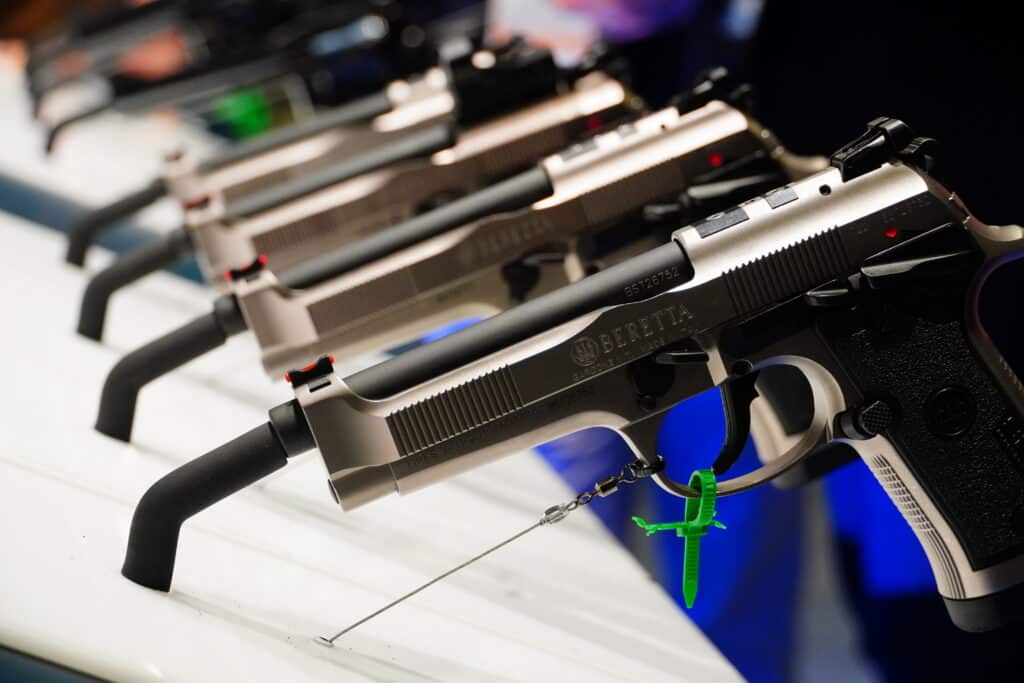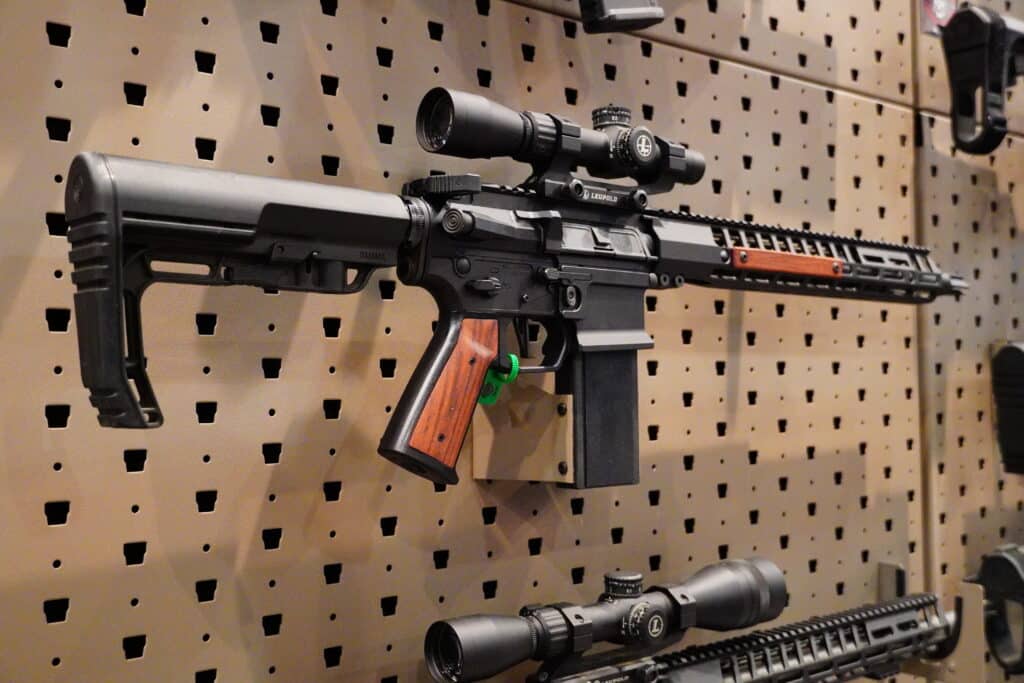This week, we’ve got something a bit different. While you’ll still get a member exclusive from me and early access to a truly great episode of the podcast, you’ll also get to read two prominent gun-rights lawyers analyze the same federal law from different perspectives.
Kostas Moros and Matt Larosiere have agreed to expand on their positions in the debate over whether the Second Amendment extends to people in the country illegally. We covered their back and forth in our piece on US v. Carbajal-Flores earlier this week. But now you’ll get a fuller account from each of them so you can make up your mind on which makes more sense.
Then I take a more detailed look at California’s program for taking guns from prohibited possessors and why it shows how impossible a mass confiscation program would really be in the United States. Contributing Writer Jake Fogleman also explains why gun-rights litigants keep losing hardware ban cases even after Bruen. And why that’s likely to continue in the near future.
Plus, the man organizing armed civilian patrols in the most dangerous parts of Connecticut’s capitol joins the podcast to discuss his plans.

Analysis: All Immigrants are Part of ‘The People’ Protected by the Second Amendment
By Matt Larosiere
On Friday, in US v. Heriberto Carbajal-Flores, a federal judge said 18 U.S.C. § 922(g)(5)’s ban on illegal immigrants owning guns violates the Second Amendment. That decision was right.

Analysis: SCOTUS is Unlikely to Agree Second Amendment Protections Extend to People Unlawfully in the US
By Konstadinos Moros
On Friday, in US v. Heriberto Carbajal-Flores, a federal judge said 18 U.S.C. § 922(g)(5)’s ban on illegal immigrants owning guns violates the Second Amendment. That decision likely misapplies the Supreme Court’s key test for gun cases.

Analysis: California’s Struggle to Seize Criminal Guns Shows the Impracticality of Mass Confiscation [Member Exclusive]
By Stephen Gutowski
California keeps having trouble taking guns away from the kind of people most Americans agree shouldn’t have them, even though it has a database full of their information. That says a lot about how unworkable mass confiscation would actually be in real life.
The Golden State crosschecks everyone in the state who has recently become prohibited from owning guns against its gun registry. It’s called the Armed and Prohibited Persons System (APPS), and the California Department of Justice (DOJ) released a report on its performance this week. It bragged that it removed more people from the list than were added to it in 2023.
“In 2023, DOJ removed 9,051 people from the APPS database of armed and prohibited persons,” the report said. “At the same time, 8,633 people were added to the APPS database of armed and prohibited persons.”
The system has been running since 2006, and this is just the fourth time it has removed more suspected prohibited possessors from the list than it added. The DOJ also reported making more contacts during its investigations than ever before. But it only reduced the number of suspected prohibited possessors by 1.75 percent.
Additionally, 23,451 people remain on the APPS list. It would take decades to clear the backlog at the rate California is moving.
And that’s not to mention the fact that California didn’t actually confiscate guns from the vast majority of the people it removed from the list last year. The state ended up confiscating fewer than 1,500 guns in total through 2023.
This is, again, a confiscation program operating under an ideal set of circumstances. The people California is trying to take guns from are those who’ve been convicted of felonies, domestic violence misdemeanors, been subject to restraining orders, or been adjudicated dangerously mentally ill. While some controversy exists over each of those prohibiting categories, especially for non-violent felons, there is broad support among the American public for disarming people with those kinds of records–and there has been for decades.
Then, of course, California has a registry of every gun sold in the state and who bought it. That’s why we know the pool of people DOJ is looking for is quite small compared to the overall number of Golden State gun owners. In fact, the report found people on the APPS list make up fewer than 0.7 percent of all registered gun owners in the state.
But, despite operating for nearly two decades, 2023’s result of essentially treading water is among the program’s best performances.
The task of confiscating guns would inevitably get progressively more difficult the further away from people who’ve been shown, through a competent judicial process, that they are a danger to themselves or others. As public support for taking guns from different groups of people declines, it will get harder to accomplish. The difficulty of that endeavor will increase exponentially as the number of people and guns that need to be accounted for rises, too.
The DOJ report found that in California alone, through just 2023, 144,242 people bought a gun for the first time.
Considering it took about 50 California law enforcement agents to round up about 1,400 guns in 2023, you’d need 5,000 agents to seize that many. But that’s only for the newest gun owners in the state and only if they own a single firearm. The DOJ report said there are 3,491,463 total registered gun owners across California.
You’d need somewhere around 115,000 officers just dedicated to confiscation to round up guns from them. A force that size would be significantly larger than California’s current population of sworn officers, according to the Public Policy Institute of California.
And that’s just California, which has the strictest gun laws in the nation and a gun ownership rate that’s likely below the national average.
Of course, we don’t know that last part for sure due to another factor that would make any sort of mass confiscation effort even more impractical. Unlike California, most states don’t have a gun registry, and the federal government is barred by law from keeping one. Nobody really knows for sure how many guns Americans writ large own or what the gun ownership rate actually is.
There are estimates, of course. None of them make the prospect of gun confiscation any more workable, though.
Polling varies, but somewhere between 40 and 50 percent of Americans report having a gun in their home. Last November, NBC News found 52 percent of American voters admitted having one. That suggests somewhere between 100 and 130 million Americans live in a home with a gun.
Estimates on the number of guns Americans own are harder to come by but no less monumental. The Small Arms Survey, part of the Geneva Graduate Institute, estimated American civilians own just under 400 million firearms. For context, they estimated American law enforcement has about a million, the American military has about 4.5 million, and all the world’s militaries combined have about 133 million.
And that was back in 2018, two years before the American public went on a record gun-buying streak.
The Trace, a publication that shares a president with the gun-control group Everytown for Gun Safety, put the high-end estimate for civilian firearms in the US at nearly 500 million as of 2023. The number could be even higher today, considering industry estimates have pegged the number of new gun sales each month at over a million for going on several years now.
Whatever the true number is, there’s no realistic chance you could hire enough police officers to round up all of those guns by force–even if they were operating under the best-case scenario that APPS is. That California can’t round up the guns of people most Americans support taking them away from under the best circumstances just goes to show how much of a fantasy any mass confiscation plan would be.
UPDATE 3-17-2024 9:22 AM EASTERN: This piece has been corrected to fix a typo on the estimated number of civilian-owned guns and the math on scaling up California’s confiscation program. The Small Arms Survey estimates there 400 million, not 400 thousand.
Podcast: The Man Behind Armed Civilian Patrols in Connecticut’s Capital City Speaks Out [Member Early Access]
By Stephen Gutowski
Crime is a significant problem in Hartford, Connecticut, and some residents don’t think local politicians and law enforcement are doing enough to combat it.
Some of those residents have now decided to do organized armed patrols in Hartford’s more dangerous neighborhoods. Cornell Lewis is one of the people doing that organizing. He runs a group called the Self-Defense Brigade, and he joined the show this week to explain his group’s tactics and motivations.
Lewis said he and the other volunteers who’ve been patrolling streets are fed up with the violence that has been carried out there. He said they want to show anyone considering committing violent crime that the community is capable of and willing to push back. The group gained local attention for its patrols last year but has gotten much more attention after it decided to step up efforts in the wake of a double homicide in the city last month.
Not everyone has welcomed the group’s efforts, though. Some local law enforcement, politicians, and community groups have said armed civilian patrols will only cause more problems for Hartford. Lewis responded to those critiques by saying the Self-Defense Brigade has no intention of being a vigilante group and is merely trying to train the community in lawful defensive techniques.
Lewis said the group’s methods have been effective, there have been no violent incidents associated with their marches, and none of the volunteers have been arrested or done anything illegal.
Plus, Contributing Writer Jake Fogleman and I discuss a federal appeals court upholding Rhode Island’s magazine ban. And we have a Reload Member on to discuss his experience as a recent convert to gun ownership in Washington, D.C.
You can listen to the show on your favorite podcasting app or by clicking here. Video of the episode is available on our YouTube channel. An auto-generated transcript is available here. Reload Members get access on Sunday, as always. Everyone else can listen when the show goes public on Monday.

Analysis: Why Gun-Rights Litigants Keep Losing Hardware Ban Challenges [Member Exclusive]
By Jake Fogleman
A federal appeals court last week dealt gun-rights advocates another blow in a lawsuit over a state arms ban.
The way states and the federal courts that oversee them have ideologically segregated themselves in the modern era of hyperpolarization means the losses are likely to continue piling up. That means a circuit split is unlikely to occur anytime soon. In turn, that reduces the chances the Supreme Court weighs in–though not to zero.
The Boston-based First Circuit Court of Appeals is the latest to uphold a modern gun hardware ban. A three-judge panel unanimously upheld Rhode Island’s total ban on “large capacity magazines” (LCMs) capable of holding more than ten rounds. The panel determined the prohibition fits within the country’s historical tradition of arms regulation.
“The justification for the law is a public safety concern comparable to the concerns justifying the historical regulation of gunpowder storage and of weapons like sawed-off shotguns, Bowie knives, M-16s and the like,” Judge William Kayatta, a Barack Obama appointee, wrote in Ocean State Tactical v. Rhode Island. “The analogical ‘how’ and ‘why’ inquiry that Bruen calls for therefore strongly points in the direction of finding that Rhode Island’s LCM ban does not violate the Second Amendment.”
That reading of the history has become commonplace among the federal judges who have upheld hardware bans in similar lawsuits.
Its basic formulation essentially states that even though there are no “directly on-point” traditions, as Judge Kayatta put it, of regulating arms like magazines and semi-automatic rifles around the time of the Founding, “unprecedented societal concerns” tied to these arms warrants “a more nuanced approach” to the historical analysis required by Bruen.
Under this more nuanced approach, judges have analogized more loosely to laws beyond the time of the Founding. This has typically involved pointing to things like late nineteenth-century Bowie knife bans or America’s first federal gun-control laws arriving in the twentieth century as evidence of a tradition of regulation brought about by new societal harms allegedly caused by technological innovations in commonly available weaponry.
These analyses have also tended to downplay the burden modern hardware bans place on the right of self-defense by declaring that popular rifles like the AR-15 or firearms equipped with magazines capable of holding more than ten rounds are “rarely” needed in self-defense situations. This looser reading of history and the purportedly modest self-defense burden have formed the basis for upholding modern arms bans.
Gun-rights advocates have heavily criticized this type of application of the history and tradition test as a misreading (intentional or otherwise) of the Supreme Court’s guidance in Heller and Bruen. However, thus far, such complaints have not met many sympathetic ears in court, particularly at the appellate level.
It’s also likely to remain that way based on a simple fact of political geography.
Bans on AR-15s and magazine capacity are currently concentrated among just a dozen or so progressive-leaning states. Those states, in turn, fall within just a few federal appeals court circuits—primarily the First, Second, Third, and Ninth—which have a track record of being more prone to uphold gun restrictions than other circuits.
There have only been three federal appeals court decisions dealing with hardware bans since Bruen. Two out of the First and Seventh Circuits have upheld bans, while a lone Ninth Circuit panel struck down Hawaii’s butterfly knife ban. Yet even that one appellate win, on non-firearms related hardware no less, is now in question after another Ninth Circuit panel vacated it to rehear the case en banc (a sign that bodes poorly for gun-rights advocates if history is any guide).
More hardware ban rulings will probably come soon from federal appeals courts elsewhere. However, once again, it does not look good for gun-rights advocates. The Third Circuit heard oral arguments last Monday in an appeal of the lower court decision upholding Delaware’s ban on AR-15s and magazines capable of holding more than 17 rounds. Oral arguments suggest the judges are skeptical of overturning the decision.
Meanwhile, an en banc panel of the Fourth Circuit just recently took the highly unusual step of agreeing to hear a lawsuit over Maryland’s “assault weapon” ban before the three-judge panel that previously heard the case could even issue an opinion—a move that signals yet another outcome gun-rights advocates are unlikely to be happy with.
Gun-rigths activists may still be able to secure lower court wins here and there or the occasional favorable panel decision. But the simple fact of the geographical sorting that has taken place with hardware bans means it’s difficult to see a circuit split ever emerging on the question. Meanwhile, judges in jurisdictions more receptive to hardware bans have coalesced around a common analytical framework for upholding them.
Until the Supreme Court steps in and says otherwise, those decisions will likely continue to set the standard for the constitutionality of modern gun bans. The Court can always take up a hardware ban case if it feels its direction isn’t being followed. But the lack of a circuit split, combined with the numerous other Second Amendment questions it is teed up to answer, may lead them to put the issue on the back burner.
That’s it for now.
I’ll talk to you all again soon.
Thanks,
Stephen Gutowski
Founder
The Reload







